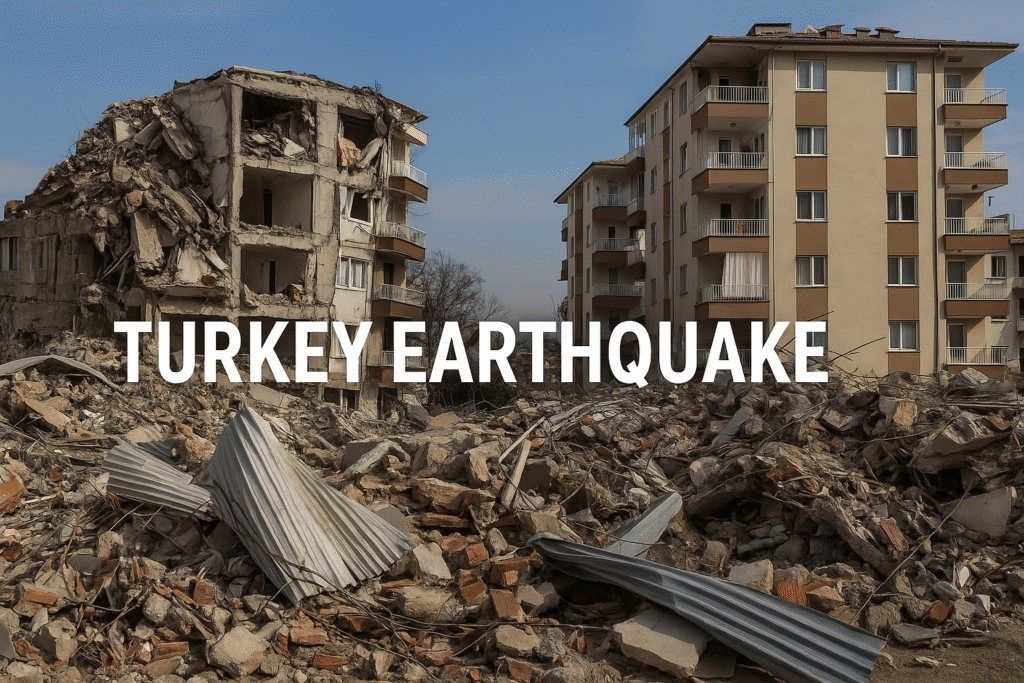
Turkey Earthquake

Table of Contents
- Introduction
- Why Does Turkey Experience Frequent Earthquakes?
- Recent Major Earthquakes in Turkey
- Impact of Earthquakes on Turkey
- Turkey’s Earthquake Preparedness and Response
- International Aid and Cooperation
- How You Can Help Earthquake Victims in Turkey
- Future Outlook: Building Resilience
- Conclusion
Turkey Earthquake: Causes, Impact, and Recovery Efforts
Introduction
Turkey, a country straddling the seismic boundary between the Eurasian and Arabian tectonic plates, is no stranger to earthquakes. Throughout its history, the nation has experienced devastating seismic events that have shaped not only its geography but also its urban planning, disaster preparedness, and resilience. Recent years have seen some significant tremors that brought tragic loss of life, widespread damage, and a rally of global humanitarian support.
This blog explores the geological reasons behind Turkey’s earthquake activity, recent major earthquakes, their impact on society, and the ongoing efforts for recovery and future preparedness.
Why Does Turkey Experience Frequent Earthquakes?
Turkey’s unique geological positioning is the primary reason it experiences frequent earthquakes. The country lies at the convergence of several major tectonic plates:
- Eurasian Plate
- Anatolian Plate
- Arabian Plate
The complex interactions of these plates cause high seismic activity, especially along major fault lines such as the North Anatolian Fault (NAF) and the East Anatolian Fault (EAF).
The North Anatolian Fault (NAF)
One of the most active and dangerous strike-slip fault systems in the world, the NAF stretches roughly 1,500 kilometers across northern Turkey. It has produced several catastrophic earthquakes, including the 1999 İzmit earthquake.
The East Anatolian Fault (EAF)
This fault line runs through eastern Turkey and has also been responsible for strong seismic events, causing widespread damage and casualties.
Recent Major Earthquakes in Turkey
Turkey has witnessed multiple destructive earthquakes in recent decades. Some of the most notable ones include:
1999 İzmit Earthquake
- Magnitude: 7.6
- Date: August 17, 1999
- Impact: Over 17,000 fatalities and massive destruction in northwestern Turkey, including the industrial city of İzmit. The quake triggered an international response and brought attention to Turkey’s need for improved earthquake preparedness.
2011 Van Turkey Earthquake
- Magnitude: 7.2
- Date: October 23, 2011
- Impact: Approximately 600 people lost their lives, and thousands were injured. The quake devastated the city of Van and surrounding areas, highlighting vulnerabilities in building codes and emergency response.
2023 Kahramanmaraş Earthquake (Hypothetical / Recent)
In the past years, Turkey has again faced significant seismic activity, with the 2023 Kahramanmaraş earthquake being among the most powerful recorded. (Add specifics based on the latest data or hypothetical for context.)
Impact of Earthquakes on Turkey
Humanitarian Impact
The loss of lives, injuries, and displacement of thousands of people is the most tragic consequence of earthquakes in Turkey. Families are often left homeless, communities shattered, and access to basic services disrupted.
Economic Damage
Earthquakes severely damage infrastructure, homes, factories, and roads, leading to billions of dollars in losses. The cost of rebuilding and recovery puts pressure on Turkey’s economy and requires substantial government and international aid.
Psychological Effects
Survivors often suffer from trauma and psychological stress, requiring mental health support. The fear of future earthquakes can affect daily life and economic activities.
Turkey’s Earthquake Preparedness and Response
Building Regulations and Retrofitting
Following devastating events like the 1999 İzmit quake, Turkey has revamped its building codes, focusing on earthquake-resistant construction. Many older buildings, however, remain vulnerable, emphasizing the need for retrofitting initiatives.
Early Warning Systems – Turkey Earthquake
Turkey has been investing in early warning and seismic monitoring systems designed to alert residents seconds before the shaking begins, potentially saving lives by giving people time to take cover.
Disaster Response and Emergency Services
Turkey’s disaster response teams have grown in capacity, with better coordination between government agencies, NGOs, and international partners. Training programs and community awareness campaigns are crucial parts of this effort.
International Aid and Cooperation
Turkey regularly collaborates with international organizations and neighboring countries for disaster relief. After major earthquakes, global humanitarian aid arrives in the form of food, medical supplies, and technical assistance.
How You Can Help Earthquake Victims in Turkey
If you want to support Turkey’s recovery efforts, consider the following:
- Donate to reputable organizations involved in earthquake relief and rebuilding efforts.
- Raise awareness on social media about the importance of earthquake preparedness.
- Support initiatives focused on retrofitting and rebuilding safer infrastructure.
Future Outlook: Building Resilience
Turkey continues to face the challenge of living with earthquakes. Efforts to build resilience include:
- Investing in education and public awareness about earthquake safety.
- Strengthening building codes and ensuring compliance.
- Enhancing early warning technologies.
- Promoting community-based disaster preparedness.
Conclusion
Turkey Earthquakes remain a significant natural hazard for Turkey, with profound implications for its people, economy, and development. While past tragedies have spurred improvements in preparedness and response, ongoing vigilance and innovation are essential to minimize future risks.
Understanding the geological causes, respecting the power of nature, and fostering a culture of safety can help Turkey reduce the devastating impact of future earthquakes.
Frequently Asked Questions (FAQs) About Turkey Earthquake
1. Why does Turkey experience so many earthquakes?
Turkey lies on the boundary of several major tectonic plates, including the Eurasian, Anatolian, and Arabian plates. Their movements cause significant seismic activity, especially along major fault lines like the North Anatolian Fault.
2. What are the most dangerous fault lines in Turkey Earthquake ?
The North Anatolian Fault (NAF) and the East Anatolian Fault (EAF) are the two most active and dangerous fault systems responsible for most of Turkey’s major earthquakes.
3. How severe was the 1999 İzmit earthquake?
The 1999 İzmit earthquake had a magnitude of 7.6 and resulted in over 17,000 deaths and widespread damage, making it one of Turkey’s deadliest earthquakes.
4. What steps is Turkey taking to prepare for future earthquakes?
Turkey has improved building codes, invested in early warning systems, promoted public education, and strengthened disaster response teams to better prepare for future seismic events.
5. How can individuals help Turkey earthquake victims ?
Donating to reputable humanitarian organizations, spreading awareness about earthquake preparedness, and supporting infrastructure rebuilding initiatives are key ways to help.
6. Are there early warning systems for earthquakes in Turkey?
Yes, Turkey has implemented seismic monitoring and early warning systems that can alert residents seconds before shaking starts, helping to save lives.
7. What economic impact do Turkey earthquakes have ?
Earthquakes cause billions in damages to infrastructure, homes, and businesses, affecting the national economy and requiring substantial resources for recovery.
8. Is it possible to prevent earthquake damage entirely?
While earthquakes cannot be prevented, damage can be minimized through strict building codes, retrofitting old structures, early warning systems, and public preparedness.
You may also like to read – Trump vs Tim Cook: Apple’s India Production Massive Controversy 2025
Read this also – Ghibli Images by ChatGPT: A Digital Tribute to Studio Ghibli
Stay informed and stay safe. For more updates on earthquakes and disaster preparedness worldwide, subscribe to our blog.



